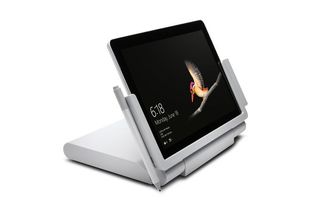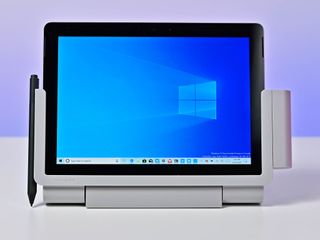Update: Microsoft has since released Surface Go 2. Because nothing has changed with that device regarding size and ports, it works just as well as Surface Go 1 with this Kensington dock.
Kensington is no stranger to making high-quality business-focused laptop and PC accessories. My review of the SD7000 Surface Pro docking station demonstrated how the Surface Pro could become a mini Surface Studio in what is undoubtedly one of the coolest accessories available.
This time it is the Microsoft Surface Go and Surface Go 2 that gets the docking treatment with the SD6000. I've spent the last few weeks using it and here is why it's excellent, and who should buy it.

From $350Bottom line:
For
- Excellent, sturdy design
- Plenty of port expansion options
- Perfect for businesses
Against
- Expensive
- Not ideal for casual consumers
SD6000 Surface Go Docking Station – Who is this for?

When first announced, the $350 SD6000 Surface Go Docking Station was mocked as being unrealistically too expensive. That would be accurate if this were being marketed as a direct consumer device, but it is geared towards "B2B" (business to business) users instead.
Kensington sees this being sold – likely in more substantial quantities – to companies for various professional use cases where a Windows 10 PC is necessitated, e.g.:
- Point-of-sale locations
- Check-in counters (like at hotel or restaurant)
- Mobile carts
- Store kiosks
- Education environments
- Conference rooms
Of course, anyone with the cash and desire can also buy it directly too. By connecting it up to multiple monitors with a full desktop keyboard and mouse, the Surface Go could quickly become your primary computer – if you're OK with the somewhat anemic Intel Pentium processor.
SD6000 Surface Go Docking Station – What is it?

The SD6000 Surface Go Docking Station is a high-end, rugged port-expanding dock station. The system is built to let the Surface Go act as the main PC or connect to extra monitors or projectors.
Users can lock-down the Surface Go using Kensington's K62918WW or K63251M keying solutions, or even add a privacy screen.


There is a massive amount of connectivity options that the SD6000 delivers, including:
- 4x USB-A 3.1 ports (5V/0.9A)
- 1x USB-C 3.1 port for data synchronization (5V/3A)
- 3.5mm combo audio jack
- Gigabit Ethernet port
- HDMI out and DisplayPort++ (Single 4K @ 60Hz; Dual 4K @ 30Hz)
- Surface Pen magnet mount
The system is powered by a standard Surface Dock AC power plug at 90 watt (included in the box).
While the SD6000 doesn't quite have the fancy hinge as the Surface Pro's SD7000 dock, it does allow the Surface Go to be tilted at various angles with ease. The Surface Go can then be locked into the dock, and the dock itself cabled to a desk so that nothing can be stolen.
Although it is unlikely for public use, there is even a magnetic side mount to hold a Surface Pen when not in use. Such a scenario is better for personal or office use than a public kiosk since there is no way to lock down the Surface Pen (unless you do a glue-chain).

It's a solid, beefy dock too that weighs a massive 5.55 pounds (2.5kg). That weight is due to the rigid construction, but also likely added so that the dock doesn't slide around (rubber feet also help it grip).
Kensington offers a three-year warranty on the SD6000, which is ideal for businesses and enterprise usage.
SD6000 Surface Go Docking Station – Verdict

In using the SD6000 Surface Go Docking Station for the last few weeks, it's hard not to appreciate it. Connecting an external display (up to 4K) with a full mouse and keyboard makes it an exciting "all-in-one" PC solution for some users who swear by the Surface Go. Adding Ethernet to the back along with four USB Type-A ports (and a Type-C one) gives infinite expansion possibilities.
For hotels, restaurants, stores, and businesses use the SD6000 seems like an excellent (and really the only) choice. The quality and heft of the SD6000 are substantial, and for those businesses that need a small, touch-screen Windows 10 PC out in the open, this dock checks all the right boxes.


Should a regular consumer buy it? It's hard to justify the $350, but if you are really fixated on just using the Surface Go all the time, then it is fantastic. Slide the Surface Go into and close the latch (which houses the Surface Connect), and you now have a full-PC setup. By using Windows 10's native screen expansion ability, you could use a large 4K display and still ink and draw on the Surface Go.
While we don't have any information on a Surface Go 2 yet, my guess is Kensington would not release this were the Surface Go 2's design to make it obsolete (it's one reason Microsoft keeps the Surface Pro line so consistent), but only time will tell.
Overall, Kensington continues to impress with these "made for" Surface accessories. They let businesses deploy Surface Go and Surface Pro for professional markets, and they're essential to have as options. That and the Kensington name makes this easy to recommend the SD6000 Surface Go Docking Station to businesses who need such a solution.

Daniel Rubino is the Editor-in-chief of Windows Central. He is also the head reviewer, podcast co-host, and analyst. He has been covering Microsoft since 2007, when this site was called WMExperts (and later Windows Phone Central). His interests include Windows, laptops, next-gen computing, and watches. He has been reviewing laptops since 2015 and is particularly fond of 2-in-1 convertibles, ARM processors, new form factors, and thin-and-light PCs. Before all this tech stuff, he worked on a Ph.D. in linguistics, watched people sleep (for medical purposes!), and ran the projectors at movie theaters because it was fun.
